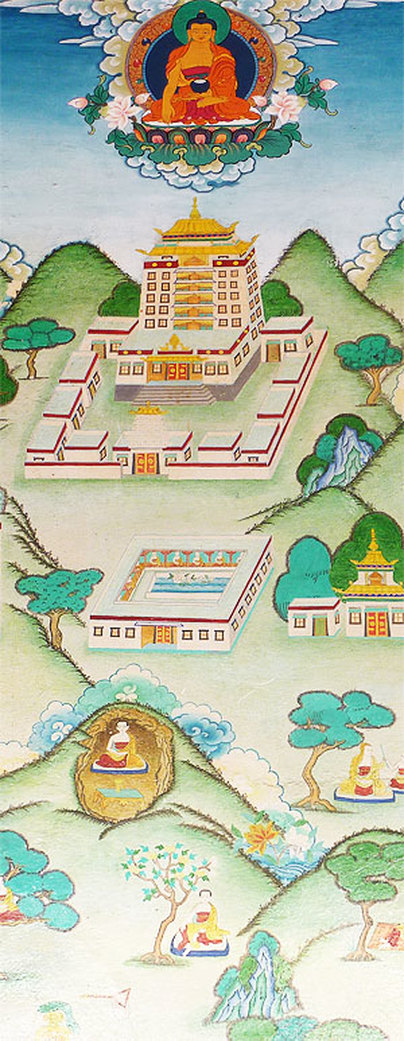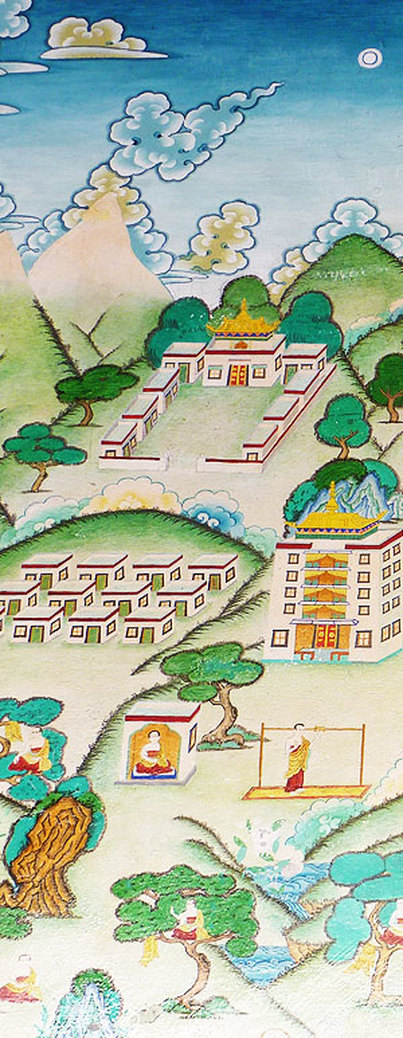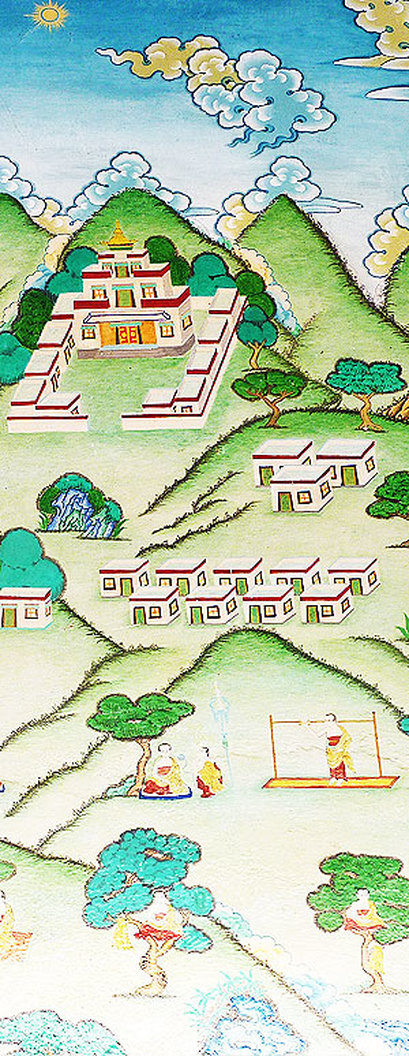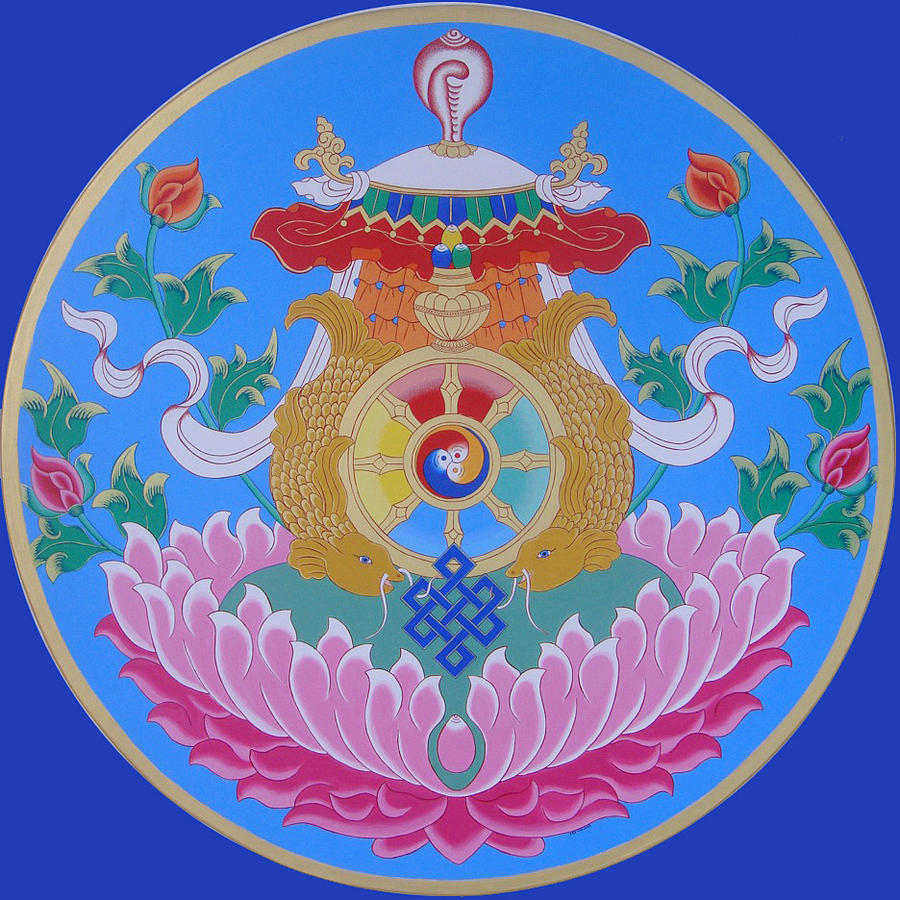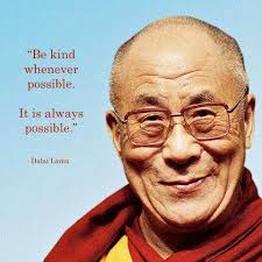Gaden Shartse History

In brief...
The Gaden Shartse tours have been visiting the United States since 1989 with a two-fold mission: to be of service to the world by helping to spread peace, compassion, and tolerance through cultural exchange, interfaith dialog, and Buddhist teachings while also raising funds to support the education, medical needs, housing, and building maintenance for the Monks at Gaden Shartse Monastery, located in a Tibetan Refugee Settlement near Mundgod in South India.
Gaden Shartse Monastery is the original Buddhist monastery of the Gelug tradition of Tibet, the same lineage or tradition as His Holiness the 14th the Dalai Lama, Tenzin Gyatso. According to Tibetan Buddhist tradition, the creation of the monastery was prophesied by the Buddha 1900 years prior to its actual establishment in 1409 CE. The monastery was housed on a large hillside about 30 miles east of Lhasa, the capital city of Tibet with a population of 5,000 Monks. The original monastery in Tibet was destroyed in 1959. It was re-established in southern India by only 48 surviving Monks. The Indian government generously donated land for a Tibetan refugee settlement, including Gaden Shartse Monastery. It has taken incredible effort in the face of unthinkable challenges to keep this precious unbroken tradition of Tibetan Buddhist teachings and culture alive over time.
The Gaden Shartse tours have been visiting the United States since 1989 with a two-fold mission: to be of service to the world by helping to spread peace, compassion, and tolerance through cultural exchange, interfaith dialog, and Buddhist teachings while also raising funds to support the education, medical needs, housing, and building maintenance for the Monks at Gaden Shartse Monastery, located in a Tibetan Refugee Settlement near Mundgod in South India.
Gaden Shartse Monastery is the original Buddhist monastery of the Gelug tradition of Tibet, the same lineage or tradition as His Holiness the 14th the Dalai Lama, Tenzin Gyatso. According to Tibetan Buddhist tradition, the creation of the monastery was prophesied by the Buddha 1900 years prior to its actual establishment in 1409 CE. The monastery was housed on a large hillside about 30 miles east of Lhasa, the capital city of Tibet with a population of 5,000 Monks. The original monastery in Tibet was destroyed in 1959. It was re-established in southern India by only 48 surviving Monks. The Indian government generously donated land for a Tibetan refugee settlement, including Gaden Shartse Monastery. It has taken incredible effort in the face of unthinkable challenges to keep this precious unbroken tradition of Tibetan Buddhist teachings and culture alive over time.
|
In depth...
Gaden Shartse Monastic College is situated amid lush green hills and jungle in the remote countryside of southern India. It was founded in 1969 as an effort to re-establish one of the great monastic traditions of Tibet. A small group of elder monks and fifteen young boys, all of whom had managed to escape the destruction in Tibet, settled on land given to them by the Indian government in Mundgod, Karnataka. Today the college is at the forefront of the revival of Tibetan Monastic education, with thousands of resident students, teachers, scholars, and spiritual practitioners. More than 70% of the members are between the ages of 10 and 25 and 80% of these were born in Tibet. To this day, young monks arrive at the Monastery weekly from Tibet, seeking shelter and education. Due to the success of the academic program and the quality of the teachers at the monastery, Gaden Shartse has established a reputation as being the leader in the field of Buddhist and Tibetan studies. mONKS IN THE COMMUNITYHISTORY OF GADEN
GADEN IN TIBET Gaden was originally founded in Tibet by Tsongkhapa (1357 - 1419), the great preacher, saint and indigenous Tibetan Buddhist scholar. In the year 1409, Tsongkhapa established Gaden Monastery and consequently the Gelugpa School or the yellow hat (as said by Chinese) section of the Tibetan Buddhism arised. Prophesies of occurrence of Tsongkhapa was done by both Buddha Shakyamuni and Guru Padmasambhava. During the time of Buddha Shakyamuni, Tsongkhapa was a young Lichavi boy, who offered a crystal rosary to Buddha and in return received a conch shell from the Buddha. Buddha then told to his attendent Ananda "in distant future this boy would be born in north and establish great monastery named Gaden".Tsongkhapa is well known emanation of Manjushri (embodiment of the wisdom of all Buddhas), Avalokiteshvara (embodiment of compassion of all Buddhas) and Vajrapani (embodiment of power of all Buddhas). The conch shell was later unearthed from the location of Gaden monastery. But it was given to the founder of Drepung monastery as an auspicious gift by Tsongkhapa. Gaden Monastery is one of the three most renowned monasteries of Tibet. It was magnificently built on a large mountain, calm, peaceful and highly suitable place for spiritual development. The monastery is located at approximately 50 kilometers east of the city of Lhasa the capital of Tibet. There are two colleges in Gaden monastery the Shartse and Jangtse. Gaden was known to have a population of more than 3,300 monks during early years of 1900. Later in 1950's the population of the monastery grew up to 5,000. Gaden quickly became well-known for its moral discipline, academic & spiritual values. Monks poured in from every part of Tibet, Mongolia, China, Japan and Northern India. Though monks came from all ages, the youngest monks started at age seven.Regardless of special focus on specific studies, all monks engaged in rigorous study programs of the monastery for many years. In addition to vast philosophical study, there were trainings in different vocations; religious music, arts, sculpture, and administrative work etc. In both colleges Shartse and Jangtse, Buddhist Sutra and Tantra are taught and practiced in a combined program. That contrasts with many other Gelug monasteries, where study of Sutra and Tantra are kept separately. Thus a monk learn in Gaden means knowledgeable in both field of Sutra and Tantra. BEGINNINGS OF GADEN IN INDIA In 1950's the People's Liberation Army of China invaded and occupied Tibet. In 1959 His Holiness the 14th Dalai Lama was forced to escape to India for safety of himself and Tibetan people. India, with deep kindness, offered Tibetans safe place to live and keep their culture and religion intact. Over hundred thousand Tibetans followed His Holiness the Dalai Lama into exile and are now living in India, Nepal and Bhutan. During the period of transition, education for the children became priority of the Exiled Tibetan Government and schools were quickly established. Many elder Tibetans perceived, in majority of these new schools, curriculum was strongly influenced by Indian style of education thus comprehensive Tibetan education was unintentionally ignored. This problem was compounded by the fact that the Cultural Revolution was puposely destroying all centers of Tibetan culture and education insideTibet. These conditions led some senior monks originated from Gaden to pool their efforts together. Under wise guidance of His Holiness Dalai Lama, with support from the Indian Government and modest contributions from fellow Tibetans, they re-establish Gaden Monastery in South India, solely to revive Tibetan education, culture and pure Buddhist teachings. SHARTSE COLLEGE IN GADEN Beginning of Gaden Monastery in India was very difficult due to the dramatic climate differences from Tibet and severe heat. In spite of all the hardships, in 1970 Gaden Shartse was formed by 85 refugee monks near the remote village of Mundgod, in the state of Karnataka, South India. The first members of Gaden Shartse settled in the refugee camps of Mundgod, a night's drive from the City of Bangalore. Initially tents were provided through donations and the monks put together a bamboo thatch structure to serve as common hall. In that humble structure they prayed, studied, debated, ate and slept. Many monks died of sickness and exhaustion. With trial and error, they learned to adjust to the new environment and were able to make modest living by cultivating the land provided to them. Over the time of four decades, population of the Shartse increased to more than 1200 monks, including resident scholar, writers, administrators and students from different parts of the world; Tibet, India, Bhutan, Nepal, Taiwan, Europe and U.S.A. Gradually, educational programs began to demonstrate sustained growth and success. Admission, instruction and accommodations were provided free of cost. Preference was always given to children who were either orphans or from very poor families. However, being located at refugee community in a developing nation and with constantly growing number of students, we are still struggling to provide good basic facilities, healthcare and other essential necessities to our students and teachers. DAILY ACTIVITIES IN GADEN SHARTSE Day starts at 6:00am when all the monks meet together at the assembly hall for the morning prayers and pujas. Monks take their breakfast at 6:30am. Then monks attend their daily classes until 11:00am and they take a lunch break for few hours. In the afternoon the junior students spend their time in the school, while senior students attend private teachings given by the assigned teachers. Dinner is served at 5:00pm. The daily debate session begins around 6.30pm and lasts until 10:30 pm, except Monday which is weekly holiday in the monastery. Most of the graduated elder monks spend most of their time in teaching students, doing spiritual practices, social and spiritual works to help public, doing administration or research in various fields of Buddhist teachings. GOALS AND OBJECTIVES OF GADEN SHARTSE 1. To preserve, diffuse and propagate the teachings of Gautama the Buddha all over the world. 2. Highly qualified buddhist monks teachers to spread real message of Buddha. 3. To enhance brotherhood amid different religious traditions of world through love, care and kindness. 4. To retain the pure teachings of Tsongkhapa with special focus on tradition passed through generations of scholars at Gaden Shartse. 5. To spread precious teachings of great Tsongkhapa all over the world to benefit all sentient beings. butter sculpting
|
the eight
|
The 2014-2016 Tour raised fund for a new three-story dormatory building that is currently
being built to house the displaced monks of the Phukhung Khangtsen.
Thank you for all of the efforts provided by all who were involved in this and past tours.
We are truly blessed and fortunate to have their influence in our community and lives.
Thank you to all monks and nuns who have taken time away from their monastic duties to share your lives with the west.
Purpose of the Tour
The purpose of touring monks is to share with all people the monks’ culture, as well as practices and paths to inner peace and compassion. Donations raised by past tours support much needed building improvements, medical needs, teachers’ salaries and the day to day expenses of supporting the khangtsen. The tour's success is due to the help and generosity of those who support the tours.
The monks of Gaden Shartse Monastery feel deeply indebted to their friends in the West who have given their time, effort, and homes to make the tours possible. It is hoped that the upcoming tour will be a success.
The purpose of touring monks is to share with all people the monks’ culture, as well as practices and paths to inner peace and compassion. Donations raised by past tours support much needed building improvements, medical needs, teachers’ salaries and the day to day expenses of supporting the khangtsen. The tour's success is due to the help and generosity of those who support the tours.
The monks of Gaden Shartse Monastery feel deeply indebted to their friends in the West who have given their time, effort, and homes to make the tours possible. It is hoped that the upcoming tour will be a success.
POB 10505, ASPEN, CO 81612 970 - 948 - 9275 [email protected]
May any merit accumulated by the creation of this website be dedicated to the benefit of all sentient beings.
And by this effort, though slight, contribute to the cessation of suffering throughout all realms.

